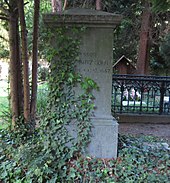Else Schmitz-Gohr
Else Schmitz-Gohr (born August 12, 1901 in Cologne ; † December 13, 1987 there ) was a German pianist, composer and piano professor.
Life
Else Schmitz-Gohr, a niece of the conductor Arthur Nikisch and sister of the violinist and singer Ria Schmitz-Gohr , made her debut at the age of 17 in Cologne's Gürzenich under the direction of Hermann Abendroth and then began a career as a soloist. She studied piano and composition at the Cologne Conservatory, a. a. with Otto Klauwell , Fritz Hans Rehbold and Franz Bölsche. In Berlin she continued her music studies at the Stern Conservatory , among others with Wilhelm Klatte (composition) and especially with James Kwast (piano), Max Reger's friend . Throughout her life she gave Reger's piano works a special place in her concert activities (see e.g. her record from 1974, published by Kaskade KAS 30067).
In 1927 Else Schmitz-Gohr took over a piano training class at the Stern Conservatory. In the following years she also gave concerts at home and abroad. In 1944 she received a teaching position at the Rheinische Musikschule in her hometown of Cologne. From 1958 to 1966 she worked as a lecturer for piano as a major at the State University of Music in Cologne . In 1960 she was finally appointed professor.
Else Schmitz-Gohr was considered an outstanding piano teacher. Her students include pianists such as the brothers Alfons and Aloys Kontarsky , Erika Rademacher, Manfred Reuthe, Joachim Volkmann, Eckart Sellheim and Ulla Graf-Nobis . After her retirement, she continued to teach private students, many of whom she prepared for piano studies at the music college. Until her death she lived - together with her two concert grand pianos (including a high-quality Steinway ) - in her old apartment at Ubierring 56.
In addition to some vinyl recordings, numerous recordings for the Westdeutscher Rundfunk Köln testify to her skills. Else Schmitz-Gohr also worked as a composer. In addition to several piano compositions, she also left behind some orchestral and chamber music works. Probably the best-known work is the "Elegy for the Left Hand" edited by Schott (in the anthology "Women composing" ED 7197).
Her grave is in the Melaten cemetery in Cologne (lit. J, between lit. A + B).
| personal data | |
|---|---|
| SURNAME | Schmitz-Gohr, Else |
| BRIEF DESCRIPTION | German composer, pianist, university teacher |
| DATE OF BIRTH | August 12, 1901 |
| PLACE OF BIRTH | Cologne |
| DATE OF DEATH | December 13, 1987 |
| Place of death | Cologne |
